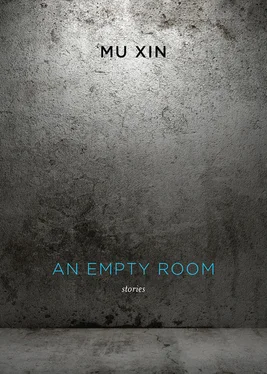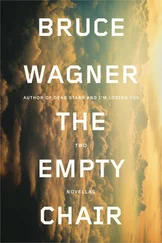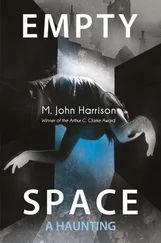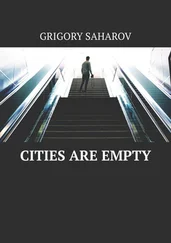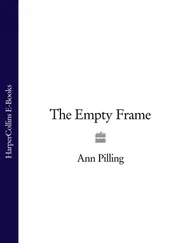Mu Xin - An Empty Room
Здесь есть возможность читать онлайн «Mu Xin - An Empty Room» весь текст электронной книги совершенно бесплатно (целиком полную версию без сокращений). В некоторых случаях можно слушать аудио, скачать через торрент в формате fb2 и присутствует краткое содержание. Год выпуска: 2011, Издательство: New Directions, Жанр: Современная проза, на английском языке. Описание произведения, (предисловие) а так же отзывы посетителей доступны на портале библиотеки ЛибКат.
- Название:An Empty Room
- Автор:
- Издательство:New Directions
- Жанр:
- Год:2011
- ISBN:нет данных
- Рейтинг книги:3 / 5. Голосов: 1
-
Избранное:Добавить в избранное
- Отзывы:
-
Ваша оценка:
- 60
- 1
- 2
- 3
- 4
- 5
An Empty Room: краткое содержание, описание и аннотация
Предлагаем к чтению аннотацию, описание, краткое содержание или предисловие (зависит от того, что написал сам автор книги «An Empty Room»). Если вы не нашли необходимую информацию о книге — напишите в комментариях, мы постараемся отыскать её.
In Our Time
An Empty Room
An Empty Room — читать онлайн бесплатно полную книгу (весь текст) целиком
Ниже представлен текст книги, разбитый по страницам. Система сохранения места последней прочитанной страницы, позволяет с удобством читать онлайн бесплатно книгу «An Empty Room», без необходимости каждый раз заново искать на чём Вы остановились. Поставьте закладку, и сможете в любой момент перейти на страницу, на которой закончили чтение.
Интервал:
Закладка:
Goethe suddenly asked, “What are you writing right now?”
Heine replied, “Faust.”
At the time, part two of Goethe’s Faust had not yet been published.
“Mr. Heine, I assume that you still have other business to attend to in Weimar.”
“The moment I stepped into your home, dear sir, all of my business in Weimar was completed.”
As soon as Heine said that, he stood up and bowed to take leave.
Such mannered behavior was quite characteristic of Goethe as it was equally characteristic of Heine.
Even tonight, a night filled with the same freezing air of spring, I’m still tormented by the desire to write the story of Faust. After all, the ink in which Faust signed his contract with Mephistopheles is not yet dry. And though it’s true Gretchen performs certain deeds, neither Helen nor Euphorion had any active roles assigned to them in the drama. The ending also seems predictable: Faust falls and is rescued. Nonetheless, when things occur and end in mythology, epic, or tragedy, they just occur and end. If one tries to revisit the events, particularly with this trinity, it is, well. . even Madame de Staël said that it was no easy task trying to write the story of Faust.
To return to the moment: After Heine left, Goethe sat alone in his living room without candlelight, and only stood up after a long while.
Heine sat in a carriage on his way to France. The fields outside were obscured by a dense fog. Heine was thinking about something that didn’t seem worth the thoughts.
Halo
in the east and in the West, artistic representations of deities, saints, or erudite monks invariably portray a halo around or above the head. Eastern paintings and statuary tend to present the frontal view of such images so that the halo, you might say, is properly positioned. Such a tendency at one time gained momentum and evolved into such forms as the Buddhist dharma-wheel and deity images of exceedingly extravagant designs. The western tradition, on the other hand, was satisfied with simply positioning a circle or an arc without any decorative intention, the effect of which is quite clean and visually pleasant. Unfortunately, however, when occidental paintings and statuary discarded a frontal perspective and adopted a side profile — or partial side profile — view, the halo needed to turn in proportion to the angle of the view and thus it ended up looking like an oval-shaped iron ring, or a bronze plate, precariously suspended above the head, causing so much anxiety. How could this possibly be the light of the divine! It appears absolutely ridiculous, so ridiculous that it is an eyesore.
In ancient times into the Middle Ages, perhaps image-making artists in the western world didn’t understand the many dimensions in space or how light works by degrees, although they did know quite a bit about anatomy and perspective. Yet depicting this ray of light above the head contradicts rudimentary rules of physics. If the halo were accurately revealed in an image according to the laws of anatomy and perspective, it would appear completely out of place and visually offensive. What otherwise could be a fine work of art would be regrettably marred and fail because of a single detail. The evident irony is this: all halos, if placed above the heads of deities, saints, and erudite monks, are false and awkward additions — a serious visual examination informed by honesty and a knowledge of nature will be enough warning for artists to not be too willful. And yet, can this be blamed on artists alone?
That I’ve always been unable to convert myself into a follower of a western religion can perhaps be attributed to my discovery of this ludicrous flaw. Oh, Lord almighty! The flaw is so embarrassing that it further inspires the eloquence of atheists.
That I’ve always been unable to convert myself into a follower of an eastern religion can perhaps be attributed to my discovery of the excessive and baroque designs of the dharma-wheel and deity portraits. Oh, the designs are so refined, so extravagant, so blindingly bright, that one cannot have a single moment of internal tranquility.
So far I’ve only spoken of the “ridiculous.” There are other things that border on the “painful.”
The older generation of Chinese scholars all know something about the life of Master Hong Yi (the Buddhist name of Li Shutong). Li Shutong was well-educated in literature, music, and painting, and became a master of calligraphy. He was once also an excellent dramatic actor, and even gender-crossed the role of Madame Camille. Li traveled east to study in Japan, emerging as a scholar who defied a world of chaos with grace. He became a role model and star of his generation. But before he left China, he had apparently married. And so upon his return with a Japanese wife, his first wife caused an enormous uproar. It is said that Li wasn’t able to resolve this peacefully and as a result lost all his worldly desires and became disillusioned with this physical, mundane world of ours. He then left for Lin Yin Temple in Hangzhou where he shaved his head and was initiated into the secluded life a monk. When his two wives rushed to the Flying Cliff, he had already chosen the practice of zuo guan — meditation in seclusion. Zuo guan is a ritual of voluntary imprisonment. The head bonze of a temple would personally seal the door of a room with some paper strips, symbolically turning the room into a secluded place, the paper strips not permitted to be removed until an agreed-upon date of release. Only meal boxes and water jars were passed in and out of the room through a small window. The two wives of the Li family knelt in front of the room and wailed, begging their husband to change his mind. For a whole day and a whole night there was absolute silence in the room, not a word issued forth in response to their wailing, revealing Li’s undaunted determination. Admirable indeed is Hong Yi’s firm resolution!
Uncle Zhao was a close friend of Master Hong Yi. It was the day I went to pay my respects to Zhao’s mother at her birthday party that I saw a calligraphy scroll of the Vajracchedika Sutra copied out by Master Hong Yi as a special gift for Uncle Zhao’s mother. The calligraphy was impressive, displaying perfect control — neither flashy nor mundane — and the use of ink was neither too watery nor too dry. There are so many calligraphic copies of Buddhist scriptures that are alike, but this scroll seemed to have risen from a unique hand — it was one thing to observe the solid foundational skills evident in the brushstrokes, and quite another thing to see its internal calmness bordering on the state of sainthood. I was in awe facing the art of a pure mind. I examined this copy of holy scripture very closely and felt a pleasure and admiration I couldn’t express in words. I didn’t dare continue looking at it.
On several occasions I had seen Master Hong Yi’s calligraphy hanging on the walls of the wealthy. His brushstrokes always conveyed an extraordinary calm. Yet I also felt an aversion thinking that this monk had wasted his ink connecting with such people. Even if one adopted the view of the Mahayana, the Great Vehicle of Buddhism, that all living creatures deserve to be rescued and brought to transcendence, I would still say that Hong Yi also desired to please rich people. And it certainly didn’t seem right if he was trying to collect alms. I was in a dilemma: it seemed more difficult to sympathize with the worldly intentions of a monk than that of a common man.
Uncle Zhao was a famous scholar, urbane and upright. A lay Buddhist himself, he was well versed in both Buddhism and Confucianism and had attained a high level of wisdom. I accompanied him one day on an excursion and we conversed over refreshing tea. He mentioned that shortly before Master Hong Yi passed away, he had gone hiking with him through the Yandang Mountains. Standing side by side with Hong Yi on top of a mountain, they both felt the high winds of the heavens and were silent. Their internal world was pure and expansive. However, as one’s countenance always betrays signs of one’s thoughts, Uncle Zhao noticed a subtle change in Hong Yi’s eyes, and so he quietly asked, “I sense you have some thoughts?”
Читать дальшеИнтервал:
Закладка:
Похожие книги на «An Empty Room»
Представляем Вашему вниманию похожие книги на «An Empty Room» списком для выбора. Мы отобрали схожую по названию и смыслу литературу в надежде предоставить читателям больше вариантов отыскать новые, интересные, ещё непрочитанные произведения.
Обсуждение, отзывы о книге «An Empty Room» и просто собственные мнения читателей. Оставьте ваши комментарии, напишите, что Вы думаете о произведении, его смысле или главных героях. Укажите что конкретно понравилось, а что нет, и почему Вы так считаете.
